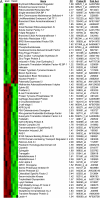Gene expression profiling of mouse teratocarcinomas uncovers epigenetic changes associated with the transformation of mouse embryonic stem cells
- PMID: 15548357
- PMCID: PMC1531652
- DOI: 10.1593/neo.04124
Gene expression profiling of mouse teratocarcinomas uncovers epigenetic changes associated with the transformation of mouse embryonic stem cells
Abstract
The molecular mechanisms of the development of teratocarcinomas from stem cells are largely unknown. To determine which genes are associated with the transformation of these cells, we have performed oligonucleotide microarray analysis, using Affymetrix U74A GeneChips, on both cell cultures and tumors in nude mice. We identified 68 genes that significantly differed in expression between the ES cell culture and the teratocarcinoma cell line, SCC-PSA1, and 51 genes with statistically different expression patterns between the ES cell tumors and the teratocarcinomas (P < .00005). We found that there were 20 genes that had common expression patterns in both groups. We also examined the role of the transition from in vitro to in vivo by comparing ES cell culture to ES cell tumor, and teratocarcinoma cell line to teratocarcinomas. We identified 22 genes that were upregulated in the ES cell tumors and 42 that had a decreased expression in the tumor (P < .0001). In comparing SCC-PSA1 to its tumor, we identified 34 upregulated genes and 25 downregulated genes (P < .001). There were only 10 genes in common from these two lists. GenMapp search revealed that several pathways, especially the cell cycle pathway, are actively involved in the induction of teratocarcinomas. Our results indicate that many key development genes may play a key role in the transformation of ES cells into teratocarcinoma cells.
Figures









References
-
- Mintz B, Fleischman RA. Teratocarcinomas and other neoplasms as developmental defects in gene expression. Adv Cancer Res. 1981;34:211–278. - PubMed
-
- Stevens LC. The development of transplantable teratocarcinomas from intratesticular grafts of pre- and postimplantation mouse embryos. Dev Biol. 1970;21:364–382. - PubMed
-
- Lockhart DJ, Dong H, Byrne MC, Follettie MT, Gallo MV, Chee MS, Mittmann M, Wang C, Kobayashi M, Horton H, Brown EL. Expression monitoring by hybridization to high-density oligonucleotide arrays. Nat Biotechnol. 1996;14(13):1675–1680. - PubMed
-
- Wodicka L, Dong H, Mittmann M, Ho MH, Lockhart DJ. Genome-wide expression monitoring in Saccharomyces cerevisiae. Nat Biotechnol. 1997;15(13):1359–1367. - PubMed
-
- Lemon WJ, Palatini JJ, Krahe R, Wright FA. Theoretical and experimental comparisons of gene expression indexes for oligonucleotidearrays. Bioinformatics. 2002;18(11):1470–1476. - PubMed
MeSH terms
LinkOut - more resources
Full Text Sources
Medical
Research Materials
